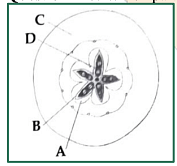
Which part of the fruit, labelled in the given figure makes it a false fruit?

Which part of the fruit, labelled in the given figure makes it a false fruit?
- A - Mesocarp
- B - Endocarp
- C - Thalamus
- D - Seed
The Correct Option is C
Solution and Explanation
In botany, a fruit is defined as the mature ovary of a flowering plant, usually containing seeds. However, a "false fruit" or "pseudocarp" includes other floral parts in addition to the ovary. In this context, the part of the fruit which contributes to making it a false fruit is the thalamus.
Explanation:
- The mesocarp is the middle layer of the pericarp, typically fleshy, and forms part of the true fruit structure.
- The endocarp is the innermost layer surrounding the seeds and is also a part of the true fruit structure.
- The thalamus is not part of the ovary itself but rather a part of the flower's receptacle and contributes to forming the fruit structure, thus creating a false fruit.
- The seed is the result of fertilized ovules and is contained within the fruit.
Thus, in the provided figure, the part labeled as the thalamus (option C) is responsible for making it a false fruit.
Top Questions on Morphology of flowering plants
- Study the lists I, II, III & IV given below and identify the mismatch.

- TS EAMCET - 2025
- Botany
- Morphology of flowering plants
- Identify the sclerenchymatous structures (parts) given below related in dicot and monocot stems:
I. Pericycle in young dicot stem
II. Hypodermis in monocot stem
III. Vascular bundle sheath in monocot stem
IV. Endodermis in dicot stem- TS EAMCET - 2025
- Botany
- Morphology of flowering plants
- Assertion (A): In Liliaceae, flowers are homochlamydeous
Reason (R): In Liliaceae perianth is differentiated- TS EAMCET - 2025
- Botany
- Morphology of flowering plants
- Unilocular (one chambered) ovary becomes bilocular (two chambered) due to the formation of false septum is seen in
- TS EAMCET - 2025
- Botany
- Morphology of flowering plants
Given below are two statements:
Statement I: In a floral formula, \(\oplus\) stands for zygomorphic nature of the flower, and \( G \) stands for the interior ovary.
Statement II: In a floral formula, \(\oplus\) stands for actinomorphic nature of the flower, and \( G \) stands for the superior ovary.
In light of the above statements, choose the correct answer from the options given below:- NEET (UG) - 2025
- Biology
- Morphology of flowering plants
Questions Asked in NEET exam
- Two identical point masses P and Q, suspended from two separate massless springs of spring constants \(k_1\) and \(k_2\), respectively, oscillate vertically. If their maximum velocities are the same, the ratio of the amplitude of P to the amplitude of Q is :
- NEET (UG) - 2025
- Waves and Oscillations
A sphere of radius R is cut from a larger solid sphere of radius 2R as shown in the figure. The ratio of the moment of inertia of the smaller sphere to that of the rest part of the sphere about the Y-axis is :

- NEET (UG) - 2025
- Moment Of Inertia
- A microscope has an objective of focal length \(f_o = 2\) cm and an eyepiece of focal length \(f_e = 4\) cm. The tube length of the microscope is \(L = 40\) cm. If the distance of distinct vision of eye is \(D = 25\) cm, the magnification in the microscope is:
- NEET (UG) - 2025
- Optical Instruments
AB is a part of an electrical circuit (see figure). The potential difference \(V_A - V_B\), at the instant when current \(i = 2\) A and is increasing at a rate of 1 amp/second is:

- NEET (UG) - 2025
- Electromagnetic Induction and Inductance
- Twins are born to a family that lives next door to you. The twins are a boy and a girl. Which of the following must be true?
- NEET (UG) - 2025
- Genetics
Concepts Used:
Morphology of Flowering Plants
Morphology in flowering plants tells us that every plant has two systems such as a root system and a shoot system. The root system digs deep into the ground and structures a system of its own. On the other hand, the shoot system is the one that is above ground level and includes various plant parts.
Root System
The descending part of the plant grows under the soil roots. During the germination process, the radicle from the seed grows earthward and branches out. The branches along with the primary root are called the root system. Roots lack chlorophyll and therefore they are not green in color. Roots are positively geotropic and hydrotropic, that is, they grow downwards ground and water, and negatively phototropic, which is growing away from light.
There are three types of root systems found in plants are as follows:
- TapRoot System
- Fibrous Root System
- Adventitious Root System
Shoot System
The stem is also an essential element of the plant. It is the ascending portion of the plant axis that bears branches, flowers, leaves, and fruits, as well as aiding in water and mineral conduction. It is the plant's aerial portion, brought about from an embryo's plumule or germinating seeds. Young stems are ordinarily green, but they finally turn woody and brown.